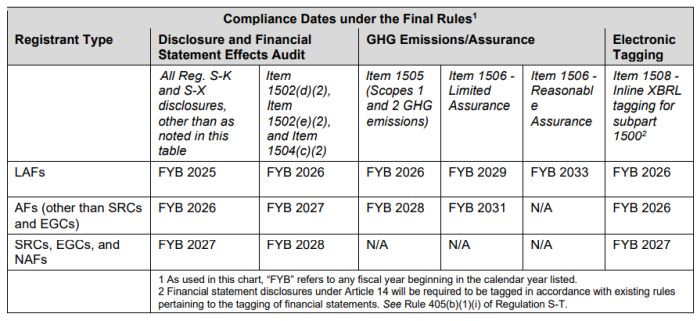- within Environment topic(s)
- in United States
- with readers working within the Consumer Industries and Utilities industries
- within Tax, Government, Public Sector and Technology topic(s)
Members of B&D's ESG, Sustainability practice will hold a webinar diving into this topic, Briefing: Final SEC Climate Disclosure Rules, on March 26. Please click here to request an invitation.
On March 6, the U.S. Securities and Exchange Commission (SEC) voted (3-2) to adopt final rules entitled, The Enhancement and Standardization of Climate-Related Disclosures for Investors (the "Final Climate Rules"). The Final Climate Rules reflect several important changes from the SEC's initial proposal but will nonetheless impose detailed and significant new disclosure obligations on corporate registrants. The Final Climate Rules phase in these obligations over a number of years according to the size of the registrant and the type of disclosure, with the first compliance period beginning in 2025. The Final Climate Rules will become effective 60 days after publication in the Federal Register.
Key Requirements & Changes from the Proposal
With extensive comments filed on the proposal and following months of engagement with stakeholders and SEC staff reviews, the Final Climate Rules reflect important changes designed to ease certain compliance challenges and provide clarity to registrants. Most notably, the Final Climate Rules:
- Eliminate the proposed requirement to disclose Scope 3 GHG emissions for all filers.
- Require Scope 1 and Scope 2 GHG emissions disclosures only for large accelerated filers (LAF) and certain accelerated filers (AF), on a phased-in basis, if material (using traditional concepts of financial materiality); related assurance requirements are also phased in.
- Exempt smaller reporting companies (SRCs) and emerging growth companies (EGCs) from the Scope 1 and Scope 2 GHG emissions disclosure requirements.
- Require climate-related risk and other core disclosures, while adopting what the SEC terms "a less prescriptive approach" for certain climate-related risk disclosures, board oversight disclosures, and risk management disclosures, to allow flexibility across different types of businesses.
- Require disclosure of transition plans (if adopted by the company), including the company's internal goals or targets to reduce GHG emissions, if part of such plan.
- Eliminate the proposed requirement to disclose what the SEC terms "Financial Impact Metrics," which would have required a line item assessment of the impact of severe weather events and other natural conditions and transition activities; the Final Climate Rules continue to require disclosure of certain financial statement effects as well as "Expenditure Metrics," or material expenditures associated with the costs and impacts of severe weather events, natural conditions, or transition plans.
- Require disclosure of certain material transition costs, including costs associated with Renewable Energy Credits or carbon offset/reduction credits when used to achieve a disclosed transition plan.
- Extend a safe harbor from private liability for certain disclosures (other than historical facts) pertaining to registrants' transition plans, scenario analyses, internal carbon pricing, and targets and goals.
- Gradually phase in the requirements, with certain aspects of mandatory reporting beginning from fiscal year 2025 and extending to all aspects of reporting by 2033.
A Closer Look at the Final Climate Rules
The Final Climate Rules, even with the SEC's clarifications and accommodations noted above, will soon require extensive and detailed disclosures in periodic reports (e.g., annual 10-K filings) and the registration statements of new issuers. At a high level, the Final Climate Rules retain much of the basic structure of the proposed rules, requiring disclosures of:
- material climate-related risks;
- impacts of such risks on strategy, business model, and outlook;
- financial statement metrics;
- information about oversight of climate-related risks by the board of directors and the role of management;
- information on any climate-related targets or goals that are material to the registrant's business, results of operations, or financial condition; and
- material GHG emissions data.
Registrants required to disclose material GHG emissions data (i.e., Scope 1 and Scope 2 emissions) must also obtain assurance and file an attestation report, in line with specified phased-in compliance dates.
Presentation of the Disclosures
The Final Climate Rules require a registrant (including a foreign private issuer) to: 1) file the climate-related disclosure in its registration statements and Exchange Act annual reports filed with the Commission; 2) provide the Regulation S-K mandated climate-related disclosures either in a separate, appropriately captioned section of its registration statement or annual report or in another appropriate section of the filing, or, by incorporating such disclosure by reference from another Commission filing as long as the disclosure meets the electronic tagging requirements of the Final Climate Rules; and 3) electronically tag climate-related disclosures in inline XBRL.
The Final Climate Rules include specific provisions on the presentation of GHG emissions metrics, i.e., Scope 1 and Scope 2 GHG emissions, where such GHG emissions metrics must be disclosed (see discussion of Material GHG Emissions Metrics Disclosure below). Recognizing that registrants may need additional time to measure and report GHG emissions beyond the deadline for filing annual reports, the Final Climate Rules allow registrants to include any required GHG emissions metrics in the 10-Q for the second fiscal quarter immediately following the year to which the metrics relate, or in an amended 10-K filed no later than the due date for the registrant's second quarter 10-Q. The Final Climate Rules establish similar provisions for foreign private issuers and new issuers.
Material Climate-Related Risks
The Final Climate Rules require disclosure of any climate-related risks that have materially impacted or are reasonably likely to have a material impact on the registrant, including its business strategy, results of operations, or financial condition.
- The Final Climate Rules define "climate-related risks" as the actual or potential negative impacts of climate-related conditions and events on a registrant's business, results of operations, or financial condition. Notably, the definition of "climate-related risks" no longer references the registrant's value chain, meaning that climate-related risk involving a registrant's value chain would generally not need to be disclosed, except where such risk has materially impacted or is reasonably likely to materially impact the registrant's business, results of operations, or financial condition (which could occur, for example, in the context of a climate-related disruption to a critical supplier that materially impacts the reporting company's operations or financial condition).
- Climate-related risks include both physical and transition risks. Examples of physical risks include risks businesses may face as a result of longer-term weather patterns, such as sustained higher temperatures, sea level rise, and drought (but, in a change from the proposal, exclude acute and chronic risks to the operations of those with whom a registrant does business). Transition risks include, but are not limited to, increased costs attributable to climate-related changes in law or policy, and risk of legal liability and litigation defense costs (but, in another change from the proposal, exclude transition risks associated with the registrant's value chain).
The Final Climate Rules require registrants to disclose whether material climate-related risks are reasonably likely to manifest in the short-term (i.e., the next 12 months), and separately in the long-term (i.e., beyond the next 12 months).
Key changes from the proposed rules: Generally, the SEC adopted what they describe as a less prescriptive approach to climate-related risk disclosures. For example, the Final Climate Rules eliminate the requirement to disclose certain information about physical risk, such as the percentage of buildings located in flood hazard areas, and the zip codes for at-risk properties. Instead, the Final Climate Rules require registrants to provide information necessary to understand the nature of the risk presented and the extent of the registrant's exposure to the risk, and provide a "non-exclusive list" of disclosures that a registrant may include, as applicable. Additionally, disclosures relating to medium-term risks are not required in the Final Climate Rules, which have simplified time horizon considerations to the short- and long-term.
Impacts of Identified Material Risks
The Final Climate Rules require registrants to describe the actual and potential material impacts of any identified climate-related risk on the registrant's strategy, business model, and outlook. The SEC included an explicit materiality qualifier, clarifying that a registrant is only required to disclose material impacts of identified climate-related risks. "Non-exclusive" examples of material impacts of climate-related risks include impacts on business operations, impacts on products or services, impacts on suppliers, purchasers, or counterparties to material contracts to the extent known or reasonably available, and activities to mitigate or adapt to risks such as the adoption of new technologies or processes. The Final Climate Rules also require registrants to discuss whether and how the registrant considers any material impacts as part of its strategy, financial planning, and capital allocation.
Key changes from the proposed rules: The proposed rules did not specifically include a materiality qualifier when requiring a registrant to describe the actual and potential impacts of any identified climate-related risks.
Governance Disclosure
The Final Climate Rules require registrants to disclose any oversight by the board of directors of material climate-related risks and describe any role management has in assessing and managing the registrant's material climate-related risks.
Key changes from the proposed rules: The Final Climate Rules eliminate, among other things, the proposed requirement to describe board members' climate expertise, and the requirement to identify specific board members responsible for climate-risk oversight.
Financial Statement Effects and 1% Threshold
The Final Climate Rules require disclosure of capitalized costs, expenditures expensed, charges, and losses incurred as a result of severe weather events and other natural conditions (such as hurricanes, tornadoes, flooding, drought, wildfires, extreme temperatures, and sea level rise) to be included in a note to a registrant's audited financial statements. These requirements are subject to a 1% disclosure threshold, and the SEC has adopted de minimis thresholds that exempt disclosure of amounts that aggregate to less than $100,000 in the income statement or less than $500,000 in the balance sheet.
The Final Climate Rules also require disclosure of material expenditures directly related to climate-related activities as part of a registrant's strategy, transition plan, and/or targets and goals disclosure requirements. These expenditures include those related to: (i) severe weather events, (ii) natural conditions, and (iii) the purchase and use of carbon offsets and/or RECs, which the SEC notes is "one type of transition activity."
Key changes from proposed rules: The Final Climate Rules remove the requirement to evaluate financial impact metrics on a line-item basis.
Transition Plan Disclosure, If Adopted
Registrants must describe their transition plan, if it has been adopted to manage a material transition risk. "Transition plan" means a registrant's strategy and implementation plan to reduce climate-related risks, which may include a plan to reduce its GHG emissions in line with its own commitments or commitments of jurisdictions within which it has significant operations. The Final Climate Rules do not require registrants to adopt a transition plan. If a registrant does not have a transition plan, then disclosure is not required. Registrants must update their annual report disclosure about the transition plan each fiscal year by describing any actions taken during the year under the plan, including how these actions impacted the registrant's business, results of operations, or financial condition. As part of this update, registrants must include quantitative and qualitative disclosure of material expenditures incurred and material impacts on financial estimates and assumptions as a direct result of the disclosed actions taken under the plan.
Key changes from the proposed rules: The SEC revised this provision to require disclosure only if a registrant adopted a transition plan to manage a material transition risk. Unlike the proposed rules, the Final Climate Rules do not list the types of transition risks and factors related to those risks that must be disclosed, if applicable.
Disclosure of Scenario Analysis, If Used
Disclosure of scenario analysis depends on whether and how a registrant uses this analysis. If a registrant uses scenario analysis to assess the impact of climate-related risks on its business, results of operations, or financial condition, and if, based on the results of scenario analysis, a registrant determines that a climate-related risk is reasonably likely to have a material impact on its business, results of operations, or financial condition, then the registrant must describe each scenario. Notably, the rules do not require registrants to conduct scenario analysis.
Key changes from the proposed rules: The SEC removed a number of provisions for this proposed disclosure with the intent to streamline it. For example, the SEC removed the proposed provision requiring the disclosure to include both qualitative and quantitative information.
Disclosure of Maintained Internal Carbon Price, If Used
Registrants that use internal carbon pricing must disclose certain information about the internal carbon price, if such use is material to how it evaluates and manages climate-related risks that it has identified as having materially impacted or as reasonably likely to have a material impact on the registrant. If the use of internal carbon pricing is material, then registrants must disclose in units of the registrant's reporting currency (i.e., the price per metric ton of carbon dioxide equivalent (CO2e); and the total price, including how the total price is estimated to change over certain time periods).
Key changes from the proposed rules: The proposed rules did not have an express materiality qualifier. The SEC also removed the requirement to describe how a registrant uses an internal carbon price to evaluate and manage climate-related risks.
Disclosure of Material Climate-Related Targets or Goals, If Any
Registrants must disclose information on their climate-related targets or goals, if any, that have materially affected or are reasonably likely to materially affect the registrant's business, operations, or financial condition. Such disclosures would include material expenditures or material financial estimates, and assumption impacts resulting from the target, goal, or related actions.
Key changes from the proposed rules: Among other things, the Final Climate Rules do not require disclosure of whether a target is absolute or intensity-based, and they do not require registrants to disclose any interim targets. Additionally, the Final Climate Rules add an express materiality qualifier.
GHG Emissions Metrics Disclosure for LAFs and AFs, If Material
The Final Climate Rules require disclosure of Scope 1 and Scope 2 GHG emissions for LAFs and AFs, but only to the extent they are material. The Final Climate Rules limit requirements for GHG disclosures for Scopes 1 and 2 to apply only to LAFs (starting in the 2026 fiscal year) and AFs (starting in the 2028 fiscal year) where such emissions are deemed material by the filer. Traditional materiality standards and the "reasonable investor" analysis will govern this assessment, which is not based on the volume of GHG emissions alone. Among other things, GHG emissions may be material if:
- The company faces a material transition risk from those emissions—here, the SEC specifically notes that such risks may arise in the context of reporting GHG emissions metrics under foreign or state laws (in the context of reporting or other financial burdens);
- The emissions are reasonably likely to impact the "business, results of operations, or financial condition in the short- or long-term;" or
- Disclosure of GHG emissions is "necessary to enable investors to understand . . . progress toward achieving a [GHG] target or goal or a transition plan," which is also disclosed under the Final Climate Rules.
These notions of materiality for GHG emissions—which are ostensibly premised on a traditional "reasonable investor" approach—are nonetheless broader than some companies might expect, particularly as further described by the SEC with respect to reporting burdens under non-SEC laws or attainment of GHG emissions targets or goals.
The Final Climate Rules require the disclosure of all GHG emissions to be expressed in the aggregate, in terms of CO2e. This requirement is a change from the proposed rules, which would have required the disclosure of GHG emissions both disaggregated by each constituent GHG and in the aggregate, as CO2e. However, if a registrant must disclose Scope 1 and/or Scope 2 emissions, and any constituent gas of the disclosed emissions is individually material, it also must disclose such constituent gas disaggregated from the other gases.
Under the Final Climate Rules, if a registrant is required to disclose its Scope 1 and/or Scope 2 emissions, it must disclose those emissions for its most recently completed fiscal year and, to the extent previously disclosed in a Commission filing, for the historical fiscal year(s) included in the consolidated financial statements included in the filing.
Notably, SRCs and EGCs are exempt from GHG emissions disclosure requirements.
Key changes from the proposed rules: The Final Climate Rules do not require disclosure of Scope 3 emissions, including the GHG emissions associated with a registrant's supply chains. However, entities subject to other reporting frameworks, such as California's Corporate Climate Data Accountability Act, may still face a separate obligation under such laws to calculate and disclose Scope 3 emissions for the relevant jurisdiction's reporting.
Assurance and Attestation
The Final Climate Rules require LAFs and AFs to file an attestation report for Scopes 1 and 2 emissions. LAFs will be required to file an attestation report at the limited assurance level beginning in the 2029 fiscal year, and at the reasonable assurance level from 2033 onward. AFs will be required to file an attestation report at the limited assurance level starting in the 2031 fiscal year. The Final Climate Rules do not require AFs to obtain an attestation report at a reasonable assurance level.
Reasonable assurance is equivalent to the level of assurance provided in an audit of a registrant's consolidated financial statements included in a Form 10-K. Limited assurance is equivalent to the level of assurance provided over a registrant's interim financial statements included in a Form 10-Q.
Key changes from the proposed rules: Compared to the proposed rules, the Final Climate Rules provide AFs and LAFs with additional time before they are required to comply with the GHG emissions assurance requirements, in addition to the phased-in GHG emissions compliance dates.
Materiality
The SEC uses its existing definition (consistent with U.S. Supreme Court precedent) of materiality throughout the Final Climate Rules – a matter is material if there is a substantial likelihood that a reasonable investor would consider it important when determining whether to buy or sell securities or how to vote. At the same time, the SEC elaborates on this standard in the context of various disclosures, as discussed above in the context of GHG emissions.
Safe Harbor from Liability
Existing forward-looking statement safe harbors are available for aspects of the climate disclosures. To the extent that climate-related disclosures constitute forward-looking statements, the forward-looking statement safe harbors provided by the Private Securities Litigation Reform Act would apply, assuming the conditions specified in those safe harbor provisions are met. The Final Climate Rules provide safe harbor provisions for disclosures pertaining to the use of an internal carbon price; scenario analysis, if used; transition plans; and targets and goals.
Key changes from the proposed rules: Initially, the proposed rules provided a safe harbor for liability for Scope 3 emissions unless it is shown that the statement was made or reaffirmed without a reasonable basis or was disclosed other than in good faith.
Phase-in Timelines / Compliance Deadlines
The phase-in timing, compliance date, and applicability of disclosure requirements depend on the type of entity. For example, LAFs are the first group of entities required to comply with disclosure requirements, followed by AFs, non-accelerated filers, EGCs, and SRCs. A number of accommodations delay or eliminate the applicability of certain types of disclosures and certain types of entities. Additionally, certain requirements also apply to foreign private issuers.
Key changes from the proposed rules: The phase-in periods were generally extended in the Final Climate Rules.
A fact sheet released by the SEC outlines disclosure placement and timing information. The Final Climate Rules will take full effect by 2033.

Source: sec.gov
Methodologies and Frameworks
The Final Climate Rules reflect many of the recommendations from the Task Force on Climate-Related Financial Disclosures (TCFD). The SEC based its GHG emissions disclosure requirements primarily on the GHG Protocol's concept of scopes and related methodology while also noting that some companies may currently employ relevant ISO standards. As such, the SEC's definition of Scope 1 and Scope 2 emissions are similar to those employed by ISO standards, and the SEC specifically permits registrants to employ "standards of their choice in calculating and disclosing GHG emissions metrics . . . including the GHG Protocol or relevant ISO standards, or other standards that may be established over time." The Final Climate Rules similarly attempt to create flexibility with respect to attestation providers and reports.
Despite this partial incorporation, the SEC's rules are distinct from other existing disclosure frameworks (i.e., ISSB, CSRD), making it difficult to apply a one-size-fits-all approach to disclosures for multi-national companies.
Context and What's Next
In 2010, the SEC released its Commission Guidance Regarding Disclosure Related to Climate Change (Feb. 8, 2010), which provided guidance on how public companies should apply then-current SEC disclosure requirements with respect to climate change matters. In March 2022, the SEC first proposed definitive climate disclosure rules. Following the 2022 proposal, stakeholders provided the SEC with over 24,000 comments, both in support of and in opposition to the rules. Throughout the process, the SEC has stated that investors seek climate-related disclosures to receive more consistent, reliable, and comparable information regarding climate-related financial risks. Stakeholders have scrutinized the rules since the initial 2022 proposal, and challenges to the Final Climate Rules already have been filed.
The attorneys general of West Virginia and Georgia are leading a coalition of 10 states in a petition to the Eleventh Circuit to review the SEC's adoption of the Final Climate Rules. The states argue that the Final Climate Rules exceed the Commission's statutory authority and otherwise are arbitrary, capricious, an abuse of discretion, and not in accordance with the law. Other groups, including the U.S. Chamber of Commerce and the Sierra Club, have suggested that they might also challenge the Final Climate Rules on various grounds. We also expect the major questions doctrine to be a component of these legal challenges, along with challenges to both the SEC's authority to adopt certain aspects of the Final Climate Rules and the specific requirements of the Final Climate Rules, with NGO groups potentially seeking more stringent disclosures, including concerning Scope 3 emissions. Members of Congress also are looking to use the Congressional Review Act to repeal the Final Climate Rules.
In addition to the SEC's Final Climate Rules, California recently enacted the state's Climate Accountability Package (SB 261, SB 253, and AB 1305), imposing climate-related disclosure obligations on certain large entities (including privately held companies) that do business in California. Meanwhile, many U.S. multinational corporations are continuing to prepare for compliance with the EU Corporate Sustainability Reporting Directive. Given the increasing complexity associated with ESG disclosure requirements globally, businesses will need to understand not only the SEC's Final Climate Rules but also the broader context.
The content of this article is intended to provide a general guide to the subject matter. Specialist advice should be sought about your specific circumstances.






